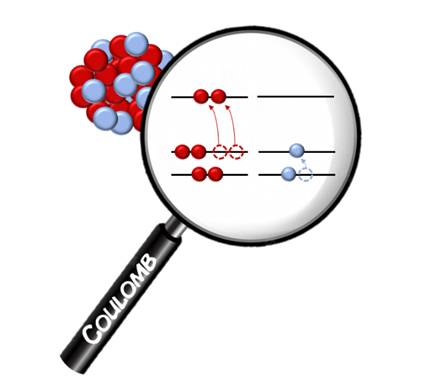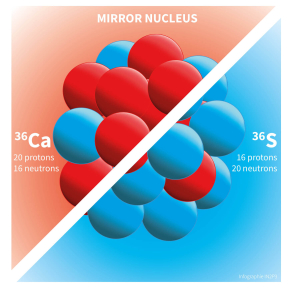Giant mirror symmetry breaking observed in an atomic nucleus
An international team, gathered around a novel experiment conducted at GANIL, has shown that some states of 36Ca have a very large energy difference with the equivalent states of its "mirror" nucleus, 36S. This discrepancy reflects a very peculiar configuration of nucleons that particularly highlights the subtle balance of forces in the atomic nucleus. These highly accurate measurements will provide an excellent test for theoretical models and improved predictions of nuclear reactions at stellar sites.
In an atomic nucleus, the strong force, which ensures the overall cohesion, is insensitive to the charge carried by the protons and consequently makes no difference between protons and neutrons. It considers them as two representations of a particle, the nucleon. This property is at the origin of the so-called isospin symmetry, one of the most fundamental symmetries of the nuclear system, which requires that so-called mirror nuclei, having the same number of nucleons, but an inverted number of protons and neutrons, all have an identical structure and energy spectrum. The presence of charges in the nuclei induces nevertheless a breaking of this symmetry which, when important, can be used to finely understand the structure of the concerned states and to characterize the role of forces in the nucleus.
An unprecedented symmetry break by its amplitude
It is a symmetry breaking, unprecedented by its amplitude, which was revealed at GANIL by a team composed of local scientists, IJCLab and RIKEN, by comparing the nuclei of the mirror pair 36Ca (20 protons and 16 neutrons) and 36S (16 protons and 20 neutrons). This pair has three excited states (1+, 2+ and 0+2) in which the symmetry breaking is unusually strong. Indeed, while the energy difference observed between mirror nuclei, the MED, for "Miror Energy Differences", is for the majority of cases at a few tens of keV at most, it reaches here 250 keV for the 1+ and 2+ states and even 500 keV for the 0+2. This is the largest known mirror energy difference for the latter, if we exclude the few rare cases involving 'fleeting' states, not bound by the nuclear interaction.

Cryogenic hydrogen target
The 36Ca isotope has been studied at the Grand Accélérateur National d'Ions Lourds in Caen. The team discovered these three excited states of 36Ca and highlighted their specific structure, using reactions where one and two neutrons are transferred from radioactive beams of 37Ca and 38Ca, with a state-of-the-art experimental setup composed of a cryogenic hydrogen target, segmented silicon and CsI MUST2 detectors, CATS beam trajectometers and a device for detecting nuclei produced at forward angles.
The comparison of the states of 36Ca with those known in 36S and produced in the mirror reaction, allowed physicists to show that, despite their differences in energy, the same excited states are populated with the same probabilities. This means that their respective structures remain similar.
This study, supported by theoretical calculations of the shell model type, allowed a better understanding of the large values of MED, in particular that for the excited state 0+2 where the MED is equal to 500 keV. For this state, the dominant configuration corresponds, in 36Ca, to the promotion of a pair of protons and a neutron to higher orbitals (see illustration), generating a change of shape of the nucleus.
In the mirror nucleus of 36S the same state will be formed by a jump of 2 neutrons and 1 proton on the upper orbitals. The jump of 2 protons in 36Ca leads to a reduction of the Coulomb repulsion, compared to its ground state, while the jump of 1 proton in 36S leads to an increase of the Coulomb repulsion, compared to its ground state. These two effects combine in a coherent way to lead to one of the largest MED ever observed in the chart of nuclides. The Coulomb force acts, by its effect on the MED, as a magnifying glass allowing to probe the structure and the shape of the excited levels, without disturbing their configurations.
Excellent tests for theoretical models
These results, recently published in Physical Review Letters, advance the knowledge on the structure and the magic character of proton-rich calcium isotopes. They are also excellent tests of theoretical models, in particular the so-called ab-initio models derived from fundamental properties and symmetry of nuclear interactions. Finally, the understanding of this mirror symmetry breaking also has an important impact in understanding the balance of forces in the atomic nucleus and in calculating the probabilities of nuclear reactions taking place in explosive stellar sites, as published by the same team in Physical Review C.
Références :
“The structure of 36Ca under the Coulomb Magnifying Glass”, Physical Review Letters 129, 122501 (2022).
“Evaluation of the 35K(p,γ)36Ca reaction rate using the 37Ca(p,d)36Ca transfer reaction”, Physical Review C 103, 055809 (2021) (PDF).
